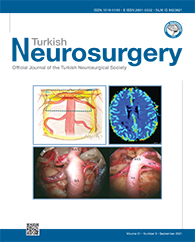2?Santa Maria Goretti? Hospital, Department of Neurosurgery, Latina, Italy
3Padova University, Treviso Regional Hospital, Department of Neurosurgery, Treviso, Italy
4?San Camillo Forlanini? Hospital, Department of Neurosurgery, Rome, Italy
5University of Barcelona, Laboratory of Surgical Neuroanatomy, Barcelona, Spain DOI : 10.5137/1019-5149.JTN.28775-19.2 AIM: To assess the feasibility of using an endoscopic-assisted lateral supraorbital (LSO) approach and an endoscopic endonasal transclival approach (EETA) for basilar apex (BAX) aneurysms.
MATERIAL and METHODS: Ten cases with LSO approaches, with or without posterior clinoidectomy and endoscopic assistance, and 10 cases with EETA, with or without drilling of the dorsum sellae, were performed on 20 cadaveric heads. Anatomical exposure and surgical freedom at the BAX were evaluated.
RESULTS: Anatomical exposure provided by the LSO approach was limited to the BAX and ipsilateral posterior cerebral artery (PCA) and increased with a mean value of 5.0 mm after posterior clinoidectomy; the basilar artery, contralateral PCA, and superior cerebellar arteries (SCAs) were visualized in all cases. Accordingly, surgical freedom was larger. Endoscopic assistance provided a significant increase in basilar artery exposure; however, surgical freedom did not increase markedly. The main advantage of EETA was the greatest exposure of the basilar artery. With drilling of the dorsum sellae, anatomical exposure increased by a mean value of 3.4 mm, and provided the greatest amount of surgical freedom and visualization of the basilar artery terminal bifurcation and of the SCAs in all cases.
CONCLUSION: The endoscopic-assisted LSO approach and the EETA may represent a feasible approach for treatment of BAX aneurysms lying within 5.0 mm below and within 3.4 mm above the dorsum sellae.
Keywords : Anatomy, Basilar apex, Endoscopic assistance, Endoscopic approach, Lateral supraorbital approach




